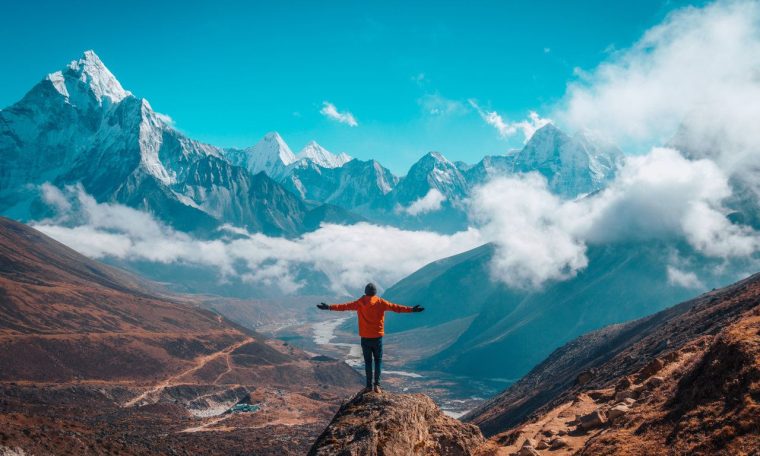
Trekking to Everest Base Camp (EBC) is an adventure that tops the bucket list of many avid hikers and nature enthusiasts. Nestled in the heart of the majestic Himalayas, this journey offers an unforgettable experience that combines breathtaking landscapes, rich cultural encounters, and the challenge of conquering one of the world’s most iconic trails.
Introduction
Nestled within the formidable embrace of the Himalayas lies an adventure that beckons to those who yearn for an unforgettable odyssey: the Everest Base Camp trek. This iconic expedition transcends the ordinary, promising an immersive experience through a landscape that dances between nature’s magnificence and human resilience.
The journey to Everest Base Camp is not merely a trek; it’s an expedition that unfolds a tapestry of breathtaking panoramas, cultural richness, and personal triumphs. Each step along the trail weaves together a narrative of challenge and awe, offering an unparalleled glimpse into the heart of the world’s highest peaks.
From the vibrant forests and ancient Sherpa villages to the daunting heights and the revered base camp of Mount Everest itself, this expedition is a symphony composed of nature’s grandeur and human determination. It’s a passage that transcends mere exploration, inviting adventurers to partake in a transformative journey that leaves an indelible mark on the soul.
Join me as we embark on a virtual exploration of the Everest Base Camp trek, a narrative that unfolds against the backdrop of towering peaks, cultural encounters, and the sheer triumph of the human spirit amidst one of the planet’s most awe-inspiring landscapes.
Overview of the Trek
The adventure typically begins with a scenic flight from Kathmandu to Lukla, a small Himalayan town. From Lukla, trekkers embark on an awe-inspiring journey that spans around 12-14 days, depending on the chosen route and acclimatization needs. The trek covers varying terrains, from lush forests and picturesque Sherpa villages to rugged mountain trails and glacial moraines.
Highlights of the Trek
Stunning Landscapes:
The trail to Everest Base Camp treats trekkers to a diverse tapestry of landscapes. Initially passing through verdant forests of rhododendron and pine, the scenery gradually shifts to rocky terrain and high-altitude landscapes. Magnificent vistas of snow-capped peaks, including Ama Dablam and Lhotse, constantly adorn the journey.
Cultural Immersion:
The trek is not only a visual feast but also an opportunity to immerse oneself in the rich Sherpa culture. Villages like Namche Bazaar, Tengboche, and Dingboche offer insights into the Sherpa way of life, with visits to monasteries, prayer flags, and encounters with friendly locals.
Everest Base Camp:
Reaching Everest Base Camp itself is the pinnacle of the journey. Standing at the foot of the world’s highest peak is an indescribable experience. Trekkers can witness the bustling camp during climbing seasons and soak in the awe-inspiring views of the Khumbu Icefall and surrounding peaks.
Kala Patthar:
For an unrivaled panoramic view of Mount Everest, many trekkers opt to hike up Kala Patthar, a vantage point sitting at approximately 5,550 meters (18,209 feet). The sunrise over Everest from this vantage point is nothing short of spectacular.
Best time to visit
The best time to embark on the Everest Base Camp trek largely depends on weather conditions and personal preferences. Typically, there are two primary trekking seasons in the Everest region:
Spring Season (March to May)
– Weather: Generally stable and mild temperatures. Clear skies offer excellent visibility for panoramic views of the Himalayas.
– Flora and Fauna: Blooming rhododendrons and vibrant vegetation add color to the landscapes.
– Crowds: Relatively high number of trekkers, especially in April and May.
– Temperature: Gradually warming temperatures, making the trek more comfortable.
Autumn Season (September to November)
– Weather: Clear skies and stable weather conditions. Excellent visibility and stunning mountain views.
– Temperature: Cool and crisp days, chilly nights at higher elevations.
– Crowds: Similar to spring, autumn witnesses a high number of trekkers, especially in October.
– Festivals: Opportunities to witness local festivals like Dashain and Tihar, offering cultural insights.
Considerations:
– Avoiding Extreme Weather: The monsoon season (June to August) and winter (December to February) generally present less favorable conditions due to heavy rainfall, snowfall, and extremely cold temperatures respectively. These periods can make trekking challenging and may limit visibility.
– Personal Preference: Some trekkers prefer quieter trails and are willing to endure colder temperatures, making late autumn or early spring feasible alternatives.
Ultimately, the choice of the best time to visit Everest Base Camp depends on a balance between weather conditions, trail conditions, personal preferences regarding crowd levels, and the kind of experience you seek from the trek. It’s advisable to plan your trip according to your comfort with weather conditions and your desire for either a quieter or more sociable trekking experience.
Challenges
While immensely rewarding, the Everest Base Camp trek poses certain challenges. The high altitude and rugged terrain demand physical endurance and acclimatization. Trekkers must be prepared for altitude sickness and changing weather conditions, necessitating a gradual ascent and adequate rest stops.
Preparation and Tips
– Physical Fitness: Preparing physically with cardio exercises and hiking can significantly enhance your trekking experience.
– Acclimatization: Gradual ascent and planned acclimatization days are crucial to avoid altitude sickness.
– Packing Essentials: Proper gear including sturdy hiking boots, layered clothing, a good backpack, and altitude-appropriate supplies are essential.
– Hydration and Nutrition: Staying hydrated and fueling your body with nutritious meals is vital at higher altitudes.
Conclusion
Embarking on the Everest Base Camp trek is a profound adventure. That encapsulates the essence of nature’s grandeur and human resilience. As trekkers navigate through the breathtaking landscapes of the Himalayas. This journey becomes a testament to determination, cultural immersion, and awe-inspiring vistas.
Choosing the ideal time to embark on this odyssey involves considering the seasons. That align with your preferences – whether it’s the vibrant bloom of spring or the crisp, clear skies of autumn. Each season offers its own unique charm and challenges, ultimately contributing to an unforgettable experience.
From the lush forests and vibrant villages to the high-altitude trails and the iconic Everest Base Camp itself. Every step along this trek is laden with awe-inspiring sights and cultural encounters. The journey fosters an appreciation for the stunning natural world. And the resilient spirit of the Sherpa people who call this region home.
Whether you seek personal triumph atop Kala Patthar, a deep immersion into Sherpa culture. Or simply a connection with the raw beauty of the Himalayas. The Everest Base Camp trek stands as an emblem of adventure and self-discovery. It leaves an indelible mark on the hearts and minds of all who dare to tread its legendary path, fostering memories. And tales that endure far beyond the last footsteps taken on this remarkable journey.



